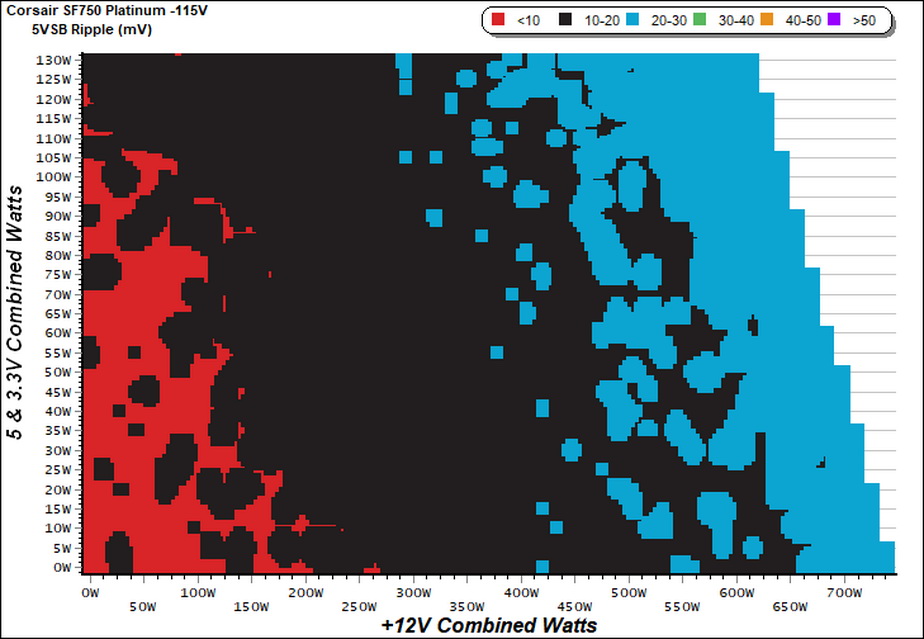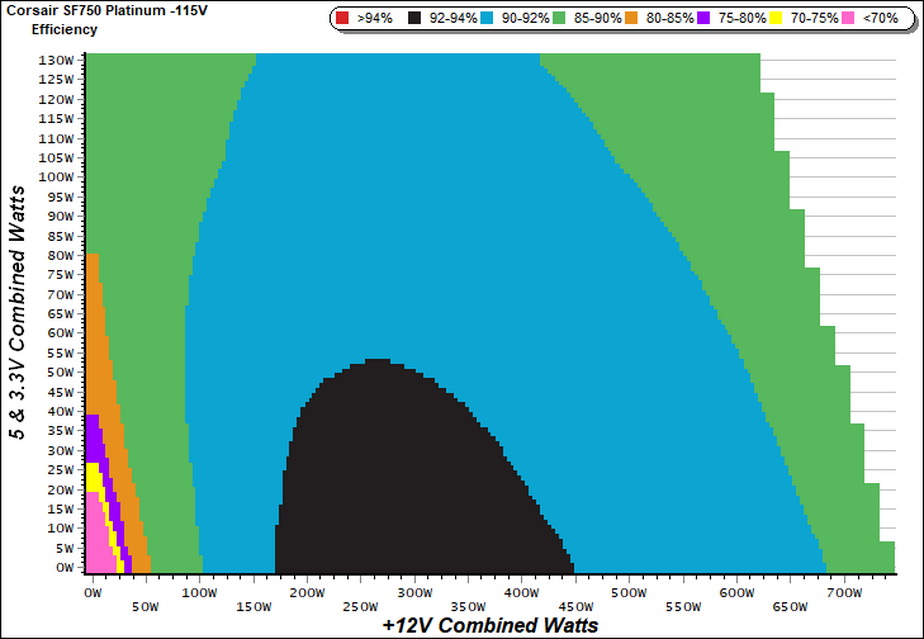Corsair SF750 PSU Review: A Tiny Power Factory
Why you can trust Tom's Hardware
Protection Features, DC Power Sequencing, Cross-Load Tests and Infrared Images
Protection Features
Check out our PSUs 101 article to learn more about PSU protection features.
| Protection Features | |
| OCP | 12V: 79.4 (127.04%), 11.992V 5V: 26.3A (131.5%), 5.055V 3.3V: 28.6A (143%), 3.352V 5VSB: 2.8A (112%), 5.009V |
| OPP | 967.3W (128.97%) |
| OTP | ✓ (185°C @ secondary side) |
| SCP | 12V: ✓ 5V: ✓ 3.3V: ✓ 5VSB: ✓ -12V: ✓ |
| PWR_OK | Proper Operation (but lower than <16ms) |
| NLO | ✓ |
| SIP | Surge: MOV Inrush: NTC Thermistor & Bypass Relay |
The unit can deliver almost 970W of power, before it shuts down because of the over power protection's triggering. Those are lots of Watts, but OPP is still set below 130% of the unit's max-power-output so it is ideally configured. The OCP on all rails but 3.3V is optimally set as well, since it is close or below 130%. Finally, the power ok signal is accurate, but it is lower than 16ms which is what the ATX spec requires.
DC Power Sequencing
According to Intel’s most recent Power Supply Design Guide (revision 1.4), the +12V and 5V outputs must be equal to or greater than the 3.3V rail at all times. Unfortunately, Intel doesn't mention why it is so important to always keep the 3.3V rail's voltage lower, than the levels of the rest two outputs.



No problems here, since the 3.3V rail's voltage is always lower than the levels of the +12V and 5V rails. We do notice though some nasty oscillations at +12V, during the last test. Those might have nothing to do with the DC power sequencing test results, but they can surely give a hard time to the system's components.
Cross Load Tests
To generate the following charts, we set our loaders to auto mode through custom-made software before trying more than 25,000 possible load combinations with the +12V, 5V, and 3.3V rails. The deviations in each of the charts below are calculated by taking the nominal values of the rails (12V, 5V, and 3.3V) as point zero. The ambient temperature during testing was between 30°C (86°F) and 32°C (89.6°F).
Load Regulation Charts



Efficiency Chart
There is a pretty large region where the efficiency levels exceed 92%, while for the most part the SF750 delivers more than 90% efficiency.
Ripple Charts
The lower the power supply's ripple the more stable the system will be and the less stress will be also applied to its components.
Get Tom's Hardware's best news and in-depth reviews, straight to your inbox.




Infrared Images
We apply a half-load for 10 minutes with the PSU's top cover and cooling fan removed before taking photos with a modified FLIR E4 camera able to deliver an IR resolution of 320x240 (76,800 pixels).







As we expected, the hottest parts are the DC-DC converters that generate the minor rails, since those ones don't use any proper heat sinks to cool down their FETs. This is why under heavy loads on the minor rails, even with a light load at +12V, the unit's fan is activated soon enough to remove the heat from those converters.
MORE: Best Power Supplies
MORE: How We Test Power Supplies
MORE: All Power Supply Content
Current page: Protection Features, DC Power Sequencing, Cross-Load Tests and Infrared Images
Prev Page Load Regulation, Hold-Up Time, Inrush Current, Efficiency and Noise Next Page Transient Response Tests, Ripple Measurements and EMC Pre-Compliance Testing
Aris Mpitziopoulos is a contributing editor at Tom's Hardware, covering PSUs.
